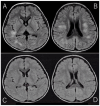Pediatric Acute Disseminated Encephalomyelitis Triggered by Concurrent Administration of Seasonal and H1N1 Influenza Vaccines: A Case Report and Review
- PMID: 39846560
- PMCID: PMC11755601
- DOI: 10.3390/neurosci6010001
Pediatric Acute Disseminated Encephalomyelitis Triggered by Concurrent Administration of Seasonal and H1N1 Influenza Vaccines: A Case Report and Review
Abstract
Background: Acute disseminated encephalomyelitis (ADEM) is a rare, immune-mediated inflammatory disorder of the central nervous system (CNS), typically characterized by the acute onset of multifocal demyelination. The pathogenesis of ADEM remains unclear, but it is believed to be triggered by an autoimmune response, often following viral infections or vaccinations.
Case report: This case report describes a 3-year-old child who developed ADEM after receiving two concurrent influenza vaccines: one for seasonal influenza and one for the 2009 H1N1 pandemic. The patient presented with motor regression, mild pleocytosis in cerebrospinal fluid (CSF), and typical MRI findings of ADEM. Steroid pulse therapy resulted in rapid improvement, and the patient recovered fully without sequelae.
Results: Although the influenza vaccine has been linked to ADEM in some studies, it remains uncertain whether the simultaneous administration of both vaccines contributed to the onset of ADEM. While influenza vaccines are considered safe and effective by health organizations such as the CDC, data suggest that the incidence of ADEM and other neurological complications is significantly higher after natural influenza infections compared to vaccination. This highlights the importance of vaccination in preventing severe outcomes.
Conclusions: This case underscores the importance of monitoring and reporting adverse events following vaccination to refine our understanding of rare complications like ADEM. While simultaneous vaccine administration warrants further research, the benefits of vaccination in preventing severe complications from natural infections far outweigh the risks. Continued vigilance and improved surveillance systems are essential for maintaining public confidence in vaccination programs.
Keywords: ADEM; H1N1; MRI; autoimmune encephalitis; child; immunological response; influenza vaccine.
Conflict of interest statement
The authors declare no conflicts of interest.
Figures


Similar articles
-
Association between seasonal influenza vaccines and the increased risk of acute disseminated encephalomyelitis, estimated using the Vaccine Adverse Event Reporting System.Pharmazie. 2022 Sep 1;77(7):262-269. doi: 10.1691/ph.2022.2354. Pharmazie. 2022. PMID: 36199182
-
Acute disseminated encephalomyelitis following 2009 H1N1 influenza vaccine.Pediatr Int. 2012 Aug;54(4):539-41. doi: 10.1111/j.1442-200X.2011.03501.x. Pediatr Int. 2012. PMID: 22830541
-
Neurological complications of influenza vaccination: navigating the spectrum with a focus on acute disseminated encephalomyelitis (ADEM).Ann Med Surg (Lond). 2024 Jan 3;86(2):1029-1041. doi: 10.1097/MS9.0000000000001656. eCollection 2024 Feb. Ann Med Surg (Lond). 2024. PMID: 38333316 Free PMC article. Review.
-
Acute disseminated encephalomyelitis with severe neurological outcomes following virosomal seasonal influenza vaccine.Hum Vaccin Immunother. 2014;10(7):1969-73. doi: 10.4161/hv.28961. Hum Vaccin Immunother. 2014. PMID: 25424806 Free PMC article.
-
Encephalitis related to a H1N1 vaccination: case report and review of the literature.Clin Neurol Neurosurg. 2014 Sep;124:8-15. doi: 10.1016/j.clineuro.2014.06.003. Epub 2014 Jun 7. Clin Neurol Neurosurg. 2014. PMID: 24996055 Review.
Cited by
-
Neurological Manifestations of Influenza Vaccination: A Narrative Review.Cureus. 2025 Apr 29;17(4):e83228. doi: 10.7759/cureus.83228. eCollection 2025 Apr. Cureus. 2025. PMID: 40453260 Free PMC article. Review.
References
-
- Neal A.H., Halsey A., Talaat K.R., Greembaum A., Mensah E., Dudley M.Z., Proveaux T., Salmon D.A. The Safety of Influenza Vaccines in Children: An Institute for Vaccine Safety White Paper. Vaccine. 2015;33:F1–F67. - PubMed
Publication types
LinkOut - more resources
Full Text Sources

